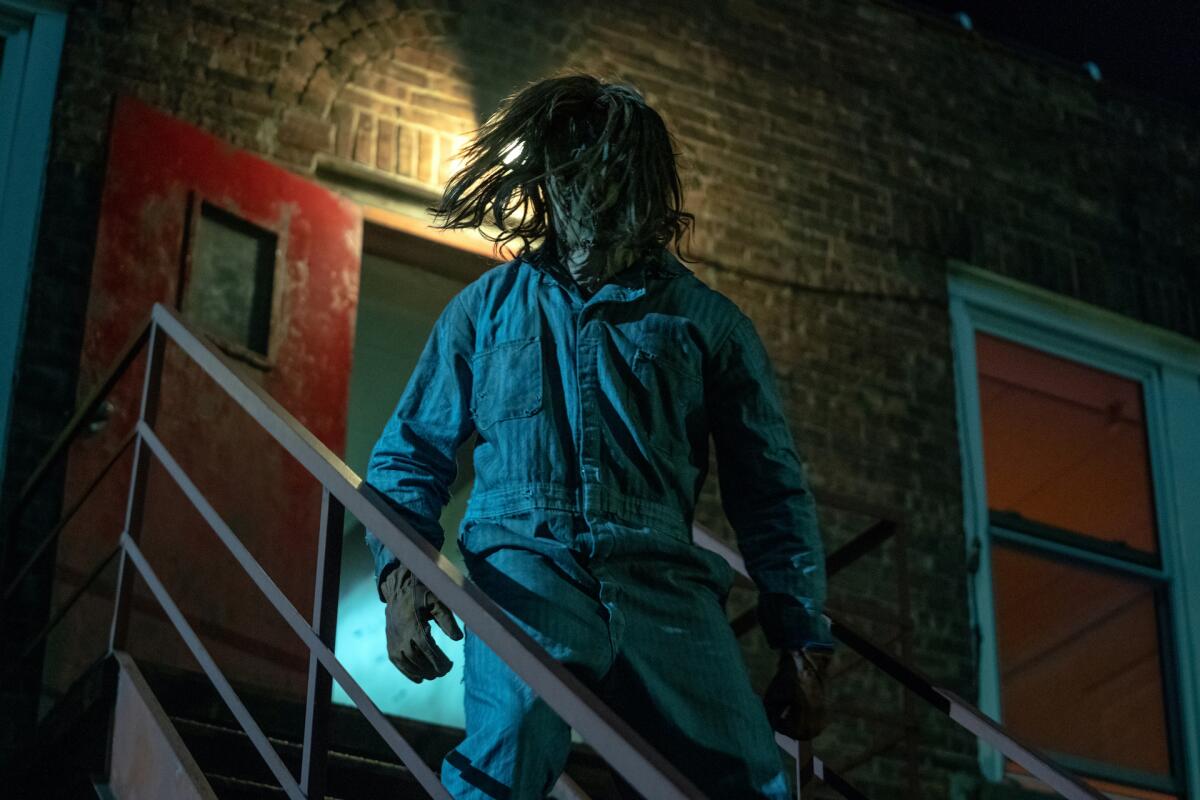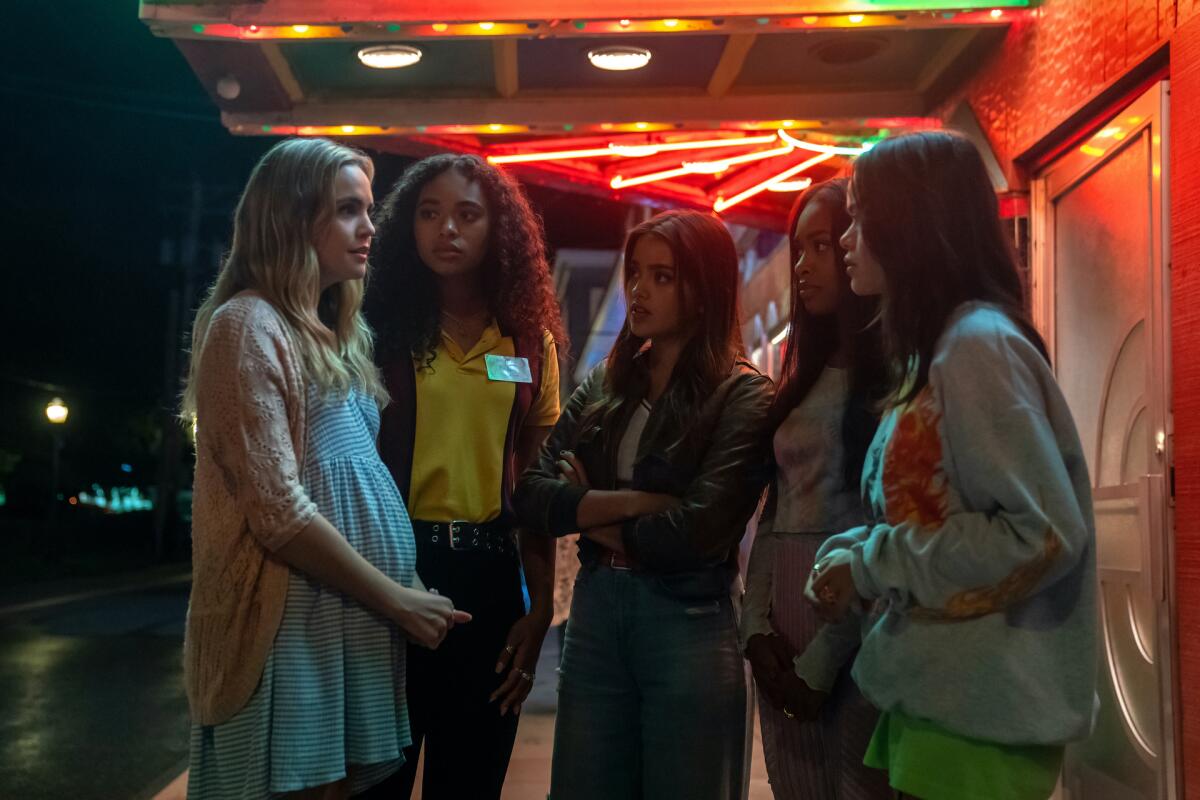How the slasher genre helped bring a beloved teen drama back from the dead

- Share via
If you’re a fan of “Pretty Little Liars,” you know that each text from “A,” the series’ anonymous tormentor, is enough to put one on edge. But in the spinoff series “Original Sin,” there’s a whole new level of fear with each cryptic message.
The HBO Max series, which concluded its first season Thursday, introduces a whole new friend group in a different town with their own A — one who is out for blood. “Original Sin,” adding to the franchise based on Sara Shepard’s young adult novels, leans into the slasher genre, standing out from the original series and its two previous spin-offs, “Ravenswood” and “Pretty Little Liars: The Perfectionists.”
In the new series, five high-school girls — Imogen Adams (Bailee Madison), Tabby Haworthe (Chandler Kinney), Faran Bryant (Zaria), Minnie “Mouse” Honrada (Malia Pyles) and Noa Olivar (Maia Reficco) — bond after A’s torments land them in detention and spark the beginning of A’s revenge for their mothers’ past offenses. Slowly, the girls uncover the truth about their mothers and the other kids at their school.
Co-creators Roberto Aguirre-Sacasa and Lindsay Calhoon Bring wanted to keep the “DNA” of “Pretty Little Liars,” but add a layer of horror to produce a fresh take. By paying homage to 1970s and ‘80s slasher films, they revitalized the franchise, embracing the scare factor of A while retaining its central focus on female friendship.
We surveyed The Times TV team to come up with a list of the 75 best TV shows you can watch on Max (formerly HBO Max). And yes, your disagreement is duly noted.
Bring, who grew up on horror fare like “Tales from the Cryptkeeper” and “A Nightmare on Elm Street,” came to Aguirre-Sacasa, whom Warner Bros. had asked to develop a new version of “PLL,” and suggested that they work together to integrate the slasher element.
“I love slashers, [but] I’d never done a slasher. The second that she brought that up, I was like, ‘I can see that, and I understand why I would be a person working on it,’” Aguirre-Sacasa says.
Alongside the mystery of A’s identity and the conventions of teen drama, each installment prompted the pair to ask, “What is the slasher-horror set piece in this episode?” Aguirre-Sacasa recalls. To achieve this consistently, they sought out images and sequences designed to give A that slasher-villain thrill: the sight of a mysterious figure across a cemetery, a chase scene over rooftops.
They also overhauled A’s image. In previous iterations of “Pretty Little Liars,” A is seen lurking in a black or red hoodie. This time around, they wanted to give A the full slasher film treatment and create a prominent “iconography” for the villain.

“One of my favorite factoids about ‘Friday the 13th’ is that the mask isn’t introduced until the third movie, but we all remember Jason with a hockey mask,” Bring says. She adds that people tend not to call horror films by their titles, but by their leading villains. For example, Freddy Krueger in “A Nightmare on Elm Street.” The creators wanted something similar for A.
They initially suggested a generic animal mask, like a jackal, but ultimately turned to director and prominent production designer Lisa Soper to push the idea further.
“We really wanted to make sure that it was unique to A,” Soper says. “I probably went through 30 or 40 different mask concepts.”
She looked at other iconic masks and narrowed them down to their common traits: zero emotion, pale complexion, hidden eyes. She started “tearing back” elements of emotion from her initial designs, “deconstructing the mask and hiding who this person is.”
The complete guide to home viewing
Get Screen Gab for everything about the TV shows and streaming movies everyone’s talking about.
You may occasionally receive promotional content from the Los Angeles Times.
She landed on a flesh mask that “felt like it could have been victims that he stitched together,” Soper says. In between pieces of flesh, the letter “A” is subtly stitched and made prominent with staples.
But though Aguirre-Sacasa and Bring pulled liberally from popular horror tropes, they purposefully left one behind: the male gaze.
“When we went back to those movies that we saw as teenagers, and probably before we were teenagers, you realize most if not all of these movies were written and directed by men and often are objectifying and exploiting young women,” Aguirre-Sacasa says.
In celebrating the genre, they wanted to also critique it. Aguirre-Sacasa recalls reading about the concept of the “final girl” in the horror genre in “Men, Women, and Chain Saws” by Carol J. Clover. Audiences see the “final girl” tormented to the very end — a victim of sadistic oppression and harassment. Bring points to the “gratuitous” shower scene in “Carrie” as an example.

Though “Original Sin” occasionally flips the script in more alarming ways, such as Tabby’s secret filming of the boys’ locker room, it also attempts to “empower” the series’ female characters through its aesthetic choices, Soper says. “Generally, when you film a woman, you’re at a slightly higher angle, looking down on them. With these girls... we would take the camera down a bit and look up.” She also assigned each girl a highly symbolic weapon. Imogen was the knife, Tabby was the hammer, Farren was the bow, Noa was the shield and Mouse was the trap.
“These girls were able to play with them individually and let them use that symbolism to help drive their characters to fight the slasher villain,” Soper says.
And despite this new iteration straying far from its predecessors in genre influence and tone, the team behind “Original Sin” believes it’s in keeping with the beloved original — especially in upholding the bond between the girls.
“We love the original Pretty Little Liars,” Aguirre-Sacasa says. “We wanted to honor them and create something that old fans and new fans could enjoy without thinking, ‘Oh, you’ve taken this thing I loved and kind of denied it or smashed it or redone it.’”
Slashed it, though? That’s a different story.
More to Read
The complete guide to home viewing
Get Screen Gab for everything about the TV shows and streaming movies everyone’s talking about.
You may occasionally receive promotional content from the Los Angeles Times.








